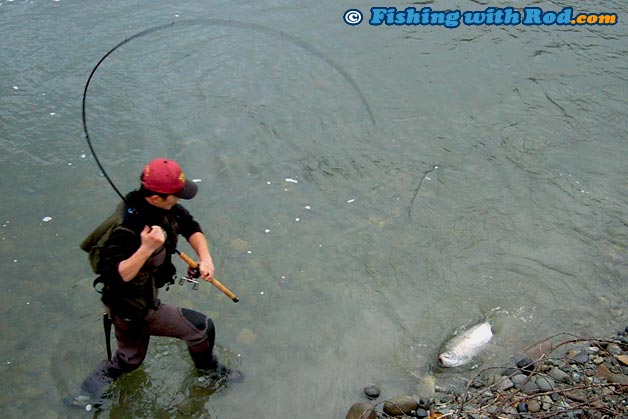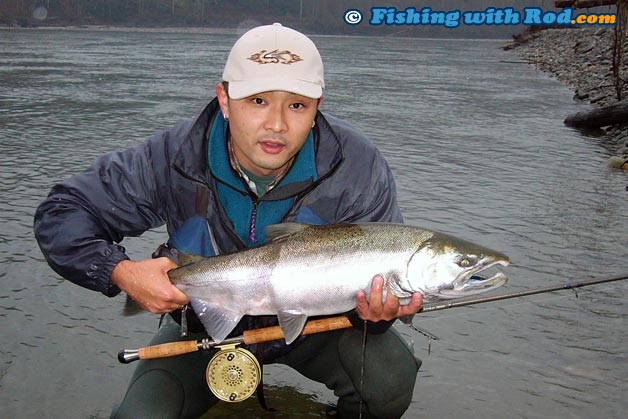Those Picky Silvers!
By Rodney Hsu, Fishing with Rod | Published in November 2004

My favorite time of the year in BC is between late August and early December. The anticipation of battling with a river-bound coho can often result in many sleepless nights. Its explosive take, feisty runs and acrobatic ways are qualities that all of us look for in a sportfish. Furthermore, what lures us to these silver bullets is their unpredictable apetite. The challenge can often turn into a frustrating game when no offerings seem to entice them.
This month's feature introduces you to the most popular natural and artificial presentations used when targeting coho salmon in Pacific Northwest rivers. They can be categorized as drift baits, spoons & spinners, and flies. Click on the links below to find out why they work, when and how to use them.
Drifting Bait

Drift fishing is by far the most popular method used among gear anglers in rivers. Drifting a float down a channel allows you to place the bait at a specific slot desired. Despite of its simplicity, many have trouble detecting a coho bite while a few are able connect with numerous fish during peak run. The problem can be dissected into three parts - Float adjustment, locating the fish and bait.
During an afternoon outing in early September, my float began to bob instead of being pulled down. Thinking it was a small trout pecking at my bait, I neglected whatever was teasing my float. This continued to take place several casts later, so at one point I decided to give the rod a slight jerk to see what would happen. What took place next completely surprised me, as the entire rod was pulled down until the tip touched the water! At the end of my line was an energetic 4lb coho that danced on the surface before being landed.
Coho can be soft biters. One of the biggest mistake anglers make is to oversize the float. A small float that requires several split shots to balance is sufficient enough to target coho. One advice that I often give is make sure only a small top portion of the float emerged from the water. This allows faster detection of bites. To avoid second guessing whether a "bite" is an actual bite or the bottom, adjust your float so your weight and bait is freely drifting a couple of feet above the river bed.
Trying to catch a coho where the coho ain't can leave you empty handed each time. Finding the fish is your number one priority before you proceed to fish. Look for waters that are not crowded by anglers and other bigger species such as chinook and chum salmon. Coho are sensitive to their surroundings. Any disturbance can put them off the bite. Seek these spots near shallow tailouts of a big run, side channels and small pools. Spending a few hours of exploring can translate into a season of coho success.
Once the fish are located, it's important to have the right bait that coho cannot resist. Common West Coast drift baits include roe chunks, egg sacs, plastic eggs, wool, spinning blades. Properly cured roe is a safe bet as it is natural and the scent can be very enticing. If sticky roe juice on your hands doesn't seem too appealing, then pre-tied egg sacs are good substitutes. The colour of these natural offerings can also play a factor. Natural colour may reduce your chance if water clarity is low. Brightly coloured bait increases number of bites as fish can spot it more quickly. When using wool, trim it until your presentation resembles a single egg. Be versatile, do not stick with one type of bait when the bites seem to be off.
Spoons & Spinners

River-bound salmon are often generalized as non feeders that are impossible to entice. This is not necessarily the case. True, their stomach cavity shrinks to make room for roe or sperm sacs, but they will still aggressively bite due to territorial behaviours.
When salmon spawning takes place, the river becomes a buffet-style feast for other species in the water. Cutthroat trout, rainbow trout, bull trout, dolly varden and various minnow species feed on salmon eggs deposited in redds. To protect their offspring, salmon will bite these smaller fish species as a defense mechanism.
Metal fishermen who take advantage of this behaviour are usually rewarded with a few big aggressive coho salmon on the end of their line. Grabbing their attention is not so easy, one has to figure out the right lure colour and size, swimming depth and speed. Once these components are mastered, you will succeed.
Typical spoon patterns employed include Gibbs Croc, Ironhead and Koho, Blue Fox Pixee, and Luhr Jensen Krocodile. Colours that have been proven to be deadly include blue, orange, pink, green and purple. When water clarity is low, choose a dark coloured spoon. When water appears to be clear, a brightly coloured spoon rarely disappoints. Spoon size depends on the depth and flow speed of your run or pool. Generally, your tackle box should contain lures that range between 1/4oz and 3/4oz.
Do not neglect spinners. A spinner can stir up an underwater party as its blade vibrates during the retrieve. That vibration is usually sensed by the lateral line of a fish, therefore it can be very effective under low visibility condition. Spinners allow an angler to slow down the retrieve because the blade creates a tremendous amount of drag at the same time. When the blade stops rotating (often felt as the line slacks), set the hook immediately!
Quite often there will be many spawners, or older fish, "hugging" onto the river bed in still waters. To avoid foul hooking these fish, downsize your lure or retrieve at a higher speed to raise your lure's swimming depth. Freshly arrived fish will not hesitate to chase down an attractive spoon or spinner. Many times a coho will follow the lure for a long time before striking, so pay close attention until the end of the retrieve.
When fishing a medium flowing run, cast your spoon upstream of you to allow the lure to sink to the depth desired. Start your retrieve when it begins to drift downstream of you. Slow your retrieve down if the lure is pushed up by the current.
Spincasting allows you to be mobile. You have the ability to effectively cover a lot of water during each outing. Normally, whether a piece of water will produce can be tested by a spoon within ten casts. Undisturbed fish will readily chase down a foreign object that swims by their field of view. Give it a try, you will be pleasantly surprised!
Artificial Flies
Fly fishing for Coho over the last few years has proven to be one of the most exciting and popular methods of fishing. Here in the Lower Mainland, we are blessed with many great streams where fresh Coho will eagerly take a well presented fly pattern. Rather than scaring fish with a float or spinner hitting the surface, a well casted fly often drifts into a group of Coho that are eager to take.
Coho Salmon are generally found in pools, tailouts, and riffled sections of a stream. Some sections cannot be fished with drift gear but are excellent pieces of fly water. Whether you are laying a tricky roll cast or casting a full fly line, use whatever the environment demands. A common error most new river fly fishermen make is not getting to the depth of the fish. Heavier weighted flies, sinking tip, full and intermediate sink lines will help you getting in the zone.
Like all fishing methods, there are drawbacks. For Coho fly fishing, river visibility and height are both major factors. No matter how good a fly fisherman's skill is, the river conditions will always make it difficult. For best fishing, first and last light are most productive. Depending on a stream's visibility it will let you decide what patterns of fly are worth trying. Generally, when the water is quite coloured a flashy coloured fly will draw a fish's attention much better than a simpler pattern often used when the water is clear. Common sense comes into play most of the time, think like a fish that is feeding in the stream.
For selecting flies, #4-10 are most productive. For Coho that are noticeably spooked, try a "sparse" tied fly. Some notable patterns are the Christmas Tree, Coho Blue, Green Woolly Bugger, Kelseys Hope and Rolled Muddler.
It will take a bit of time to learn the basics but with more experience gained from each trip, the better chance you have of catching a Coho on the fly. There is no better feeling than seeing a fresh Coho go aerial with a fly in its mouth.

